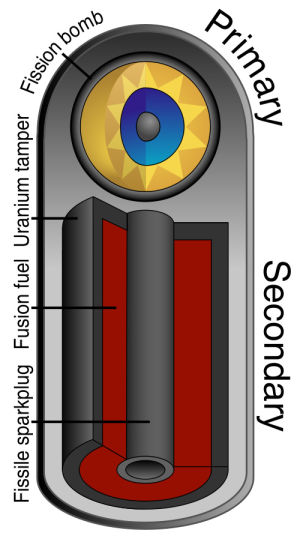Table Of Content

Using lithium deuteride instead of liquid deuterium eliminated the need for cumbersome cryogenic equipment. All thermonuclear weapons existing in the world today appear to be based on a scheme usually called the "Teller-Ulam" design (after its inventors Stanislaw Ulan and Edward Teller), or "staged radiation implosion" for a physically descriptive designation. Other designs have been devised that use thermonuclear reactions to enhance weapon yield in various ways, but the term "hydrogen bomb" can be taken to be virtually synonymous with this scheme.
March 8, 2015
Although there were attempts to use the great energy of thermonuclear explosions for peaceful uses like heating water in underground caverns, mining or hydraulic fracking for gas mining, it was never achieved. Further innovation in miniaturizing warheads continued through the mid-1970s, however, much of the Teller-Ulam design for these weapons and older are considered a top nuclear secret. Most information in the public domain about these designs is relegated to a few terse statements by the Department of Energy and the work of a few individual investigators.
Nuclear fusion
The result of all this, though, was a report signed by Teller and Ulam titled “On Heterocatalytic Detonations I. Hydrodynamic Lenses and Radiation Mirrors,” report # LAMS-1225, dated March 9, 1951. We’ll get to the “heterocatalytic” in a moment, but the “hydrodynamic lenses” are the initial Ulam compression scheme; the “radiation mirrors” is related to Teller’s insights with regards to radiation implosion. This is in distinction to hitherto-considered autocatalytic schemes based essentially on self-implosions of a mixture of nuclear substances. That it took Teller — and everyone else at Los Alamos — a full ten years to figure out how to solve the problem is a good indication that it was a very hard problem.
United States History of Thermonuclear Weapons Development
This ablation process, essentially a rocket turned inside out, generates tremendous pressure on the fuel capsule and causes an accelerating implosion. Thermal equilibrium assures that the implosion pressure is very uniformly distributed. The transparent carbon-hydrogen plasma retards the early expansion of the tamper and casing plasmas, keeping the radiation channel from being blocked by these opaque high-Z materials until equilibrium is fully established. The first transportable US bomb was Castle Bravo, which used lithium deuteride, which is solid at room temperature. Its yield was 2.5 times greater than predicted because of unforeseen additional reactions involving lithium 7.
A thermonuclear weapon or more commonly known as a hydrogen bomb/H-bomb is a two-stage nuclear weapon that uses the energy from a principal nuclear fission reaction to ignite a secondary reaction. It is referred to as a hydrogen bomb because it primarily employs the hydrogen fusion process. This results in an increased explosion power when compared to other single stage devices. Such weapons are currently considered as those that have the largest megaton yield. The Teller-Ulam configuration makes use of the fact that at the high temperatures of a fission bomb 80% or more of the energy exists as soft X-rays, not kinetic energy.
Ivy Mike
The transport of energy by radiation from the fission core greatly exceeds the core's expansion rate (a mere 1000 km/sec or so). It is possible then to use this energy to compress, and ignite a physically separate mass of fusion fuel (the seond stage) through radiation implosion before the expanding trigger disrupts it. Using the easy to ignite, but very costly, tritium-deuterium fuel it is possible to ignite a reasonably efficient fusion burn in fuel at normal densities using the heat from a fission explosion ( million degrees K). However, it is militarily desirable to use fuels that are cheaper, and more stable than tritium.
The work required to compress a gas is proportional to its temperature (at these pressures the physical strength of materials is negligible, and everything can be considered a gas). To minimize the work required for compression, or alternatively to achieve maximum compression for a given amount of work, it is important to keep the fusion fuel from getting hot until after the desired density is reached. In September 1951, Los Alamos proposed a test of the Teller-Ulam concept for November 1952. The device weighed 82 tons, in part because of cryogenic (low-temperature) refrigeration equipment necessary to keep the deuterium in liquid form. It was successfully detonated during Operation Ivy, on November 1, 1952, at Enewetak.
Responses to “The Infamous Teller-Ulam Report ( ”
This led to a large radioactive contamination of the east part of the Bikini atoll. By an explosion of one or several conventional auxiliary fission bombs, one hopes to establish conditions for the explosion of a “principal” bomb. The force that compresses and accelerates the fusion fuel inward is provided solely by the ablation pressure. To make use of these fuels, the slower reaction rates must be offset by compressing them to densities hundreds or thousands of times greater than those of normal conditions. At any given temperature the reaction rate goes up with the square of the density, a thousand-fold compression gives a million-fold reaction rate increase. The bomb was the first full-scale test of the Teller-Ulam design, and its explosion completely destroyed the test island Elugelab, leaving a nearly 2 km wide crater where the island had once been.
This Explains Why Russia's City-Destroying Tsar Bomba Was Only Tested Once - The National Interest Online
This Explains Why Russia's City-Destroying Tsar Bomba Was Only Tested Once.
Posted: Sat, 14 Mar 2020 07:00:00 GMT [source]
With the completion of Castle, the feasibility of lightweight, solid-fuel thermonuclear weapons was proved. Refinements of the basic two-stage Teller-Ulam configuration resulted in thermonuclear weapons with a wide variety of characteristics and applications. Some high-yield deliverable weapons incorporated additional thermonuclear fuel (lithium deuteride) and fissionable material (uranium-235 and uranium-238) in a third stage.
Gordon Dean, chairman of the AEC, convened a meeting at the Institute for Advanced Study in Princeton, New Jersey, hosted by Oppenheimer, on June 16–17, 1951, where the new idea was discussed. In attendance were the GAC members, AEC commissioners, and key scientists and consultants from Los Alamos and Princeton. The participants were unanimously in favour of active and rapid pursuit of the Teller-Ulam principle. The other means became apparent between February and April 1951, following breakthroughs achieved at Los Alamos.
For the next decade, Teller would commit a significant amount of his time to the effort of trying to figure out how you could make such a thing actually work. Just prior to the conference, on May 8 at Enewetak atoll in the western Pacific, a test explosion named George had successfully used a fission bomb to ignite a small quantity of deuterium and tritium. It was immediately clear to all scientists concerned that these new ideas—achieving a high density in the thermonuclear fuel by compression using a fission primary—provided for the first time a firm basis for a fusion weapon.
The H-Bomb Case Revisited - Progressive.org - Progressive.org
The H-Bomb Case Revisited - Progressive.org.
Posted: Thu, 01 Aug 2019 07:00:00 GMT [source]
The bomb casing is roughly cylindrical, with the fission Primary (or "trigger") at one end. The fusion fuel (lithium deuteride in the diagram) is a cylinder or ellipsoid wrapped in a pusher/tamper - a layer of very dense material (uranium or tungsten). Running down the axis of the fuel cylinder is a Pu-239 or U-235 rod, 2-3 cm or so in diameter.
The first device used to demonstrate the hydrogen bomb principle was the Greenhouse Item, detonated in 1951 on the island of the Pacific atoll Enewetak. It was not a true fission bomb and was never intended to be a weapon, but it demonstrated that the direction of thermonuclear bomb research was correct. The deuterium-tritium gas was inserted into the enriched-uranium core of the fission bomb. The neutrons generated from fusion helped to burn fissile fuel and nearly double the yield of a fission bomb. Work on the hydrogen bomb was carried out together with the fission bomb development.
Biographic Memoirs Volume 90 contains the biographies of deceased members of the National Academy of Sciences and bibliographies of their published works. Each biographical essay was written by a member of the Academy familiar with the professional career of the deceased. For historical and bibliographical purposes, these volumes are worth returning to time and again.
Anyway, after the section quoted above, we have several totally blanked out pages. Then we have some rather technical discussion of sound velocities in various medium; presumably this involves Ulam’s plan to use the shock wave of the fission bomb to compress the “secondary” system. So they’re using “heterocatalytic” as a foil to “autocatalytic.” An autocatalytic reaction is one where the reaction is increased by the action of the reaction itself.


No comments:
Post a Comment